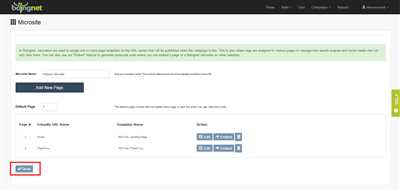
A microsite is a powerful means of promoting and creating sale opportunities for your business. Unlike a complete website, a microsite is focused on a specific campaign or product, giving users a comprehensive look at what your brand offers. Although it serves as an auxiliary to your main website, a microsite uses its own domain and can provide more targeted information to your customers.
So, why would you need a microsite when you already have an excellent website? The answer lies in the unique benefits it brings. Microsites are designed with a specific action in mind, whether it’s to increase brand awareness, generate leads, or drive sales. Studies show that customers are more likely to take action on a microsite, as it is tailored to their specific need or interest.
But how do you begin building a microsite? Here’s a step-by-step guide to help you get started:
- Determine your goal: Before you begin, you need to define the purpose of your microsite. Are you looking to launch a new product, promote an event, or change the perception of your brand? Identifying your goal will help you tailor the content and design of your microsite.
- Do your research: Once you know your goal, study the best practices and examples of successful microsites. Look at what other companies in your industry are doing and take note of what works and what doesn’t. There are also many online resources and case studies available to provide valuable insights.
- Create a compelling message: Your microsite should have a focused message that resonates with your target audience. Think about what sets your product or service apart and how it can benefit your customers. Craft a clear and compelling message that will capture the attention of your visitors.
- Build the microsite: Now it’s time to put your plan into action and start building your microsite. Use user-friendly tools and platforms to create a visually appealing and functional website. Make sure the design and layout are consistent with your branding to maintain a cohesive look.
- Generate traffic: A microsite is only effective if people can find it. Use various channels like SEO, social media, email marketing, and paid advertising to drive traffic to your microsite. It’s important to have a well-rounded promotional strategy to ensure maximum visibility.
- Track and optimize: Once your microsite is launched, track its performance using analytics tools. Monitor key metrics like traffic, engagement, and conversions to see how well it is performing. Use this data to make informed decisions and optimize your microsite for better results.
By following these steps, you can create a highly targeted microsite that effectively promotes your brand and drives action from your audience. So, don’t just rely on your main website – start harnessing the power of microsites to reach your business goals.
What is a microsite
A microsite is a smaller, focused website that a company creates to complement its main website. It usually has its own domain name and is designed to provide a more complete and specific digital experience to its audiences. While a company’s main website may cover a wide range of products or services, a microsite is dedicated to a single topic, campaign, or event.
Microsites are often used as a marketing tool to drive traffic and engage users with specific messages or content. They are typically created as a part of a larger marketing campaign or branding initiative. Microsites can be used to display seasonal promotions, launch new products, generate leads, or provide a platform for users to interact with a brand in a more personalized way.
One example of a microsite is Google’s “Think with Google” platform. This microsite provides a comprehensive guide to digital marketing best practices, with each chapter focusing on a specific topic. By offering valuable content and tools, Google aims to increase brand awareness and attract potential buyers who are looking for marketing solutions.
Microsites offer several benefits for companies. First, they allow for more focused and targeted messaging. By creating a microsite, a company can tailor its content specifically to the audience and action it wants to drive. Second, microsites provide a platform to showcase a company’s expertise and establish thought leadership in a particular field. Third, they offer the opportunity to experiment and try out new ideas without impacting the main website.
When making a microsite, it’s important to keep a few best practices in mind. First, the design of the microsite should be consistent with the overall branding of the company. This helps to create a seamless experience for users and contributes to brand recognition. Second, the microsite should be easy to navigate and provide clear calls to action. Users should be able to quickly find the information they are looking for and complete the desired action.
In conclusion, a microsite is a highly focused and targeted website that a company creates to complement its main website. It is designed to provide a more complete and specific digital experience to its audiences, usually for a specific campaign or event. By using a microsite, companies can drive traffic, engage users with specific messages, and increase brand awareness. While a company’s main website may cover a wide range of products or services, a microsite allows for a more personalized and targeted approach.
Sources

When it comes to building a microsite, there are a variety of solutions and practices you can follow to ensure a highly optimized and user-focused experience. Here’s a comprehensive guide to some of the best sources and tools you can use:
– Online marketing agencies: If you’re looking to build a smaller microsite as part of a larger digital marketing campaign, partnering with an agency can provide the expertise and resources required to develop a successful site. These agencies usually have a team of experts who can help you plan, design, and launch your microsite, giving you more control over your branding and messaging.
– Social media platforms: In addition to your main website, social media platforms can be a powerful tool for generating traffic and leads. By creating a dedicated landing page on platforms like Facebook or Instagram, you can drive targeted audiences to your microsite and increase their engagement with your brand.
– National park websites: If you’re building a microsite for a seasonal or national park, these websites often provide valuable information and resources on best practices for building and optimizing your site. They also offer insights into user behavior and trends in the park industry, helping you tailor your microsite to meet the needs and expectations of your target audience.
– SEO tools and guides: Building a microsite means you’ll need to focus on search engine optimization (SEO) to ensure your site is easily discoverable by search engines and attracts the right readers. There are many SEO tools and guides available online that can help you understand the best practices for optimizing your microsite for search engines.
– Industry-specific forums and communities: Depending on the topic or theme of your microsite, there may be industry-specific forums or communities where you can find valuable insights and information. Joining these communities can help you stay updated on the latest trends and best practices, giving you a competitive edge in your niche market.
– User feedback and testing: Once your microsite is built, it’s important to gather user feedback and test its performance. This means conducting user surveys, A/B testing different elements of your site, and analyzing user behavior using tools like Google Analytics. By collecting and analyzing this data, you can make informed decisions on how to improve and optimize your microsite for better user experience.
– Online communities for web developers: If you’re a web developer looking to build a highly functional and visually appealing microsite, there are online communities and forums where you can share ideas and learn from others. These communities often provide valuable insights and tips on best practices in web development, which can help you create a microsite that stands out from the competition.
With these sources, you’ll have the information and tools you need to build a successful microsite that meets your goals and objectives. Whether you’re looking to increase brand awareness, generate leads, or provide a comprehensive online resource, a well-built and optimized microsite can be a game-changer for your digital marketing strategy.









